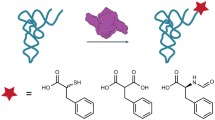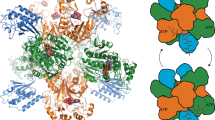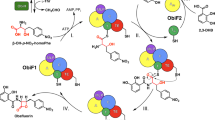Abstract
ε-Poly-L-lysine (ε-PL) consists of 25–35 L-lysine residues in isopeptide linkages and is one of only two amino acid homopolymers known in nature. Elucidating the biosynthetic mechanism of ε-PL should open new avenues for creating novel classes of biopolymers. Here we report the purification of an ε-PL synthetase (Pls; 130 kDa) and the cloning of its gene from an ε-PL–producing strain of Streptomyces albulus. Pls was found to be a membrane protein with adenylation and thiolation domains characteristic of the nonribosomal peptide synthetases (NRPSs). It had no traditional condensation or thioesterase domain; instead, it had six transmembrane domains surrounding three tandem soluble domains. These tandem domains iteratively catalyzed L-lysine polymerization using free L-lysine polymer (or monomer in the initial reaction) as acceptor and Pls-bound L-lysine as donor, directly yielding chains of diverse length. Thus, Pls is a new single-module NRPS having an amino acid ligase–like catalytic activity for peptide bond formation.
This is a preview of subscription content, access via your institution
Access options
Subscribe to this journal
Receive 12 print issues and online access
$259.00 per year
only $21.58 per issue
Buy this article
- Purchase on Springer Link
- Instant access to full article PDF
Prices may be subject to local taxes which are calculated during checkout







Similar content being viewed by others
Accession codes
References
Oppermann Sanio, F.B. & Steinbuchel, A. Occurrence, functions and biosynthesis of polyamides in microorganisms and biotechnological production. Naturwissenschaften 89, 11–22 (2002).
Shima, S., Matsuoka, H., Iwamoto, T. & Sakai, H. Antimicrobial action of ε-poly-l-lysine. J. Antibiot. (Tokyo) 37, 1449–1455 (1984).
Walsh, C. Antibiotics: Action, Origins, Resistance (American Society for Microbiology, Washington DC, 2003).
Schwarzer, D., Finking, R. & Marahiel, M.A. Nonribosomal peptides: from genes to products. Nat. Prod. Rep. 20, 275–287 (2003).
Mootz, H.D., Schwarzer, D. & Marahiel, M.A. Ways of assembling complex natural products on modular nonribosomal peptide synthetases. ChemBioChem 3, 490–504 (2002).
Marahiel, M.A., Stachelhaus, T. & Mootz, H.D. Modular peptide synthases involved in nonribosomal peptide synthesis. Chem. Rev. 97, 2651–2673 (1997).
Kawai, T., Kubota, T., Hiraki, J. & Izumi, Y. Biosynthesis of ε-poly-l-lysine in a cell-free system of Streptomyces albulus. Biochem. Biophys. Res. Commun. 311, 635–640 (2003).
Saimura, M., Takehara, M., Mizukami, S., Kataoka, K. & Hirohara, H. Biosynthesis of nearly monodispersed poly(epsilon-L-lysine) in Streptomyces species. Biotechnol. Lett. 30, 377–385 (2008).
Hamano, Y. et al. Biological function of the pld gene product that degrades ε-poly-l-lysine in Streptomyces albulus. Appl. Microbiol. Biotechnol. 72, 173–181 (2006).
Challis, G.L., Ravel, J. & Townsend, C.A. Predictive, structure-based model of amino acid recognition by nonribosomal peptide synthetase adenylation domains. Chem. Biol. 7, 211–224 (2000).
Hibi, T. et al. Crystal structure of gamma-glutamylcysteine synthetase: insights into the mechanism of catalysis by a key enzyme for glutathione homeostasis. Proc. Natl. Acad. Sci. USA 101, 15052–15057 (2004).
Hirokawa, T., Boon Chieng, S. & Mitaku, S. SOSUI: classification and secondary structure prediction system for membrane proteins. Bioinformatics 14, 378–379 (1998).
Bergendahl, V., Linne, U. & Marahiel, M.A. Mutational analysis of the C-domain in nonribosomal peptide synthesis. Eur. J. Biochem. 269, 620–629 (2002).
Keating, T.A., Marshall, C.G., Walsh, C.T. & Keating, A.E. The structure of VibH represents nonribosomal peptide synthetase condensation, cyclization and epimerization domains. Nat. Struct. Biol. 9, 522–526 (2002).
Nishikawa, M. & Ogawa, K. Distribution of microbes producing antimicrobial ε-poly-l-lysine polymers in soil microflora determined by a novel method. Appl. Environ. Microbiol. 68, 3575–3581 (2002).
Bierman, M. et al. Plasmid cloning vectors for the conjugal transfer of DNA from Escherichia coli to Streptomyces spp. Gene 116, 43–49 (1992).
Hamano, Y. et al. Development of gene delivery systems for the ε-poly-l-lysine producer, Streptomyces albulus. J. Biosci. Bioeng. 99, 636–641 (2005).
Hamano, Y., Maruyama, C. & Kimoto, H. Construction of a knockout mutant of the streptothricin-resistance gene in Streptomyces albulus by electroporation. Actinomycetologica 20, 35–41 (2006).
Keller, U. Actinomycin synthetases. J. Biol. Chem. 262, 5852–5856 (1987).
Acknowledgements
We thank M. Kobayashi (The University of Tsukuba, Japan) for providing plasmid pHSA81. This work was supported in part by KAKENHI (18780061), a Grant-in-Aid for young scientists (B), to Y.H. from the Japan Society for the Promotion of Science (JSPS).
Author information
Authors and Affiliations
Contributions
Y.H., K.Y. and H.T. conceived and designed the experiments; Y.H., K.Y. and C.M. performed the experiments; and K.Y. and Y.H. wrote the paper.
Corresponding author
Ethics declarations
Competing interests
Y.H. and K.Y. have submitted a patent application related to the practical application of polylysine synthetase; some claims in this application are supported by this work.
Supplementary information
Supplementary Text and Figures
Supplementary Figures 1–3, Supplementary Tables 1–6 and Supplementary Methods (PDF 2803 kb)
Rights and permissions
About this article
Cite this article
Yamanaka, K., Maruyama, C., Takagi, H. et al. ε-Poly-L-lysine dispersity is controlled by a highly unusual nonribosomal peptide synthetase. Nat Chem Biol 4, 766–772 (2008). https://doi.org/10.1038/nchembio.125
Received:
Accepted:
Published:
Issue Date:
DOI: https://doi.org/10.1038/nchembio.125
This article is cited by
-
Enhanced ε‑poly‑l‑lysine production in Streptomyces species by combining interspecific hybridization with multiple antibiotic resistance
Bioprocess and Biosystems Engineering (2024)
-
Engineering Streptomyces albulus to enhance ε-poly-L-lysine production by introducing a polyphosphate kinase-mediated ATP regeneration system
Microbial Cell Factories (2023)
-
Constitutive and high gene expression in the diaminopimelate pathway accelerates ε-poly-l-lysine production in Streptomyces albulus
The Journal of Antibiotics (2023)
-
Advances in the adenylation domain: discovery of diverse non-ribosomal peptides
Applied Microbiology and Biotechnology (2023)
-
Physiological analysis of the improved ε-polylysine production induced by reactive oxygen species
Applied Microbiology and Biotechnology (2023)



